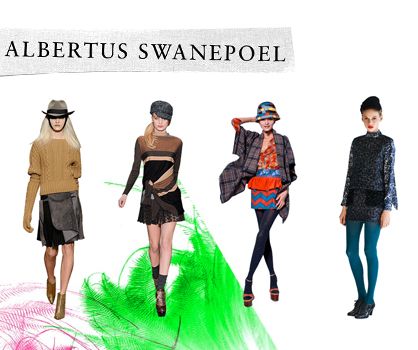Q&A: Albertus Swanepoel
In the 1980s, Albertus Swanepoel was known in his native South Africa for designing his label, Quartus Manna. His excellence in design won him the Coty Award in 1987 as top designer in the country. In 1989 he decided to abandon it all and head to the Big Apple, leaving his successful name and clothing line in the dust. Starting anew, Swanepoel established himself as a freelance hat maker, studying under acclaimed milliners and attending the Fashion Institute of Technology in New York. But it wasn’t until a gig for a Proenza Schouler show that the designer realized he could make a living as a milliner.
LadyLUX: How did you start out?
Albertus Swanepoel: I went to military training, and then university to study graphic design. In my final year, I realized that I was very interested in fashion and then went to a fashion school.
I had my own company in South Africa, making made-to-measure clothing for people for seven years and became a sort-of acclaimed designer in South Africa. I won a huge award there, and I was pretty well known. In ’89 I left for New York, and, by a complete fluke, I got a job.
LL: What was the job?
AS: It was for a sportswear company. It was actually some South Africans that had a company here. They heard me speaking my native language, which is Afrikaans, which is like Dutch. They approached me and then said, “Fantastic, we need a designer. Will you come work for us?” I was completely enthralled with New York and took the job. The job fell through after a year. So my then-wife and I started making gloves. We started a little business doing that, but, because it was a winter business, for six months of the year we had nothing to do.
In 2004 I met somebody from Marc Jacobs at a party, and they asked me to do the hats for the runway show, Marc by Marc, and I started doing that. Shortly thereafter, I started doing the hats for Proenza Schouler – their first runway show – and word got out from there, and I started doing hats for a lot of runway shows. Two years later, I formed my own company and my own little collection.
During Proenza, I was still freelancing. I was working for a milliner and hand-weaving on the weekends in Connecticut to get by.
It was tough. It was a long sort of struggle in a way. My big break came when I did the second Proenza show (SS 2007). Laird Borelli actually wrote a huge write-up on me on Style.com, and I suddenly got a huge amount of interest from stores to show my own collection. I actually didn’t have a women’s collection at that point and had to come up with one very quickly, within a few weeks. Barney’s, Bergdorfs, Neiman Marcus and Henri Bendel all approached me after this article came out and wanted to see my own work. I started my own company then.
LL: You mentioned Proenza’s SS ’07 show was your big break. What was that like?
AS: It was completely surreal. I just remember the morning after that thing on Style.com came out. The show wanted like five hats in the beginning, and then suddenly it became 10, and then they wanted a hat on every model. I didn’t sleep for like two nights before the show. We worked straight through. I remember opening my e-mail the morning after and seeing like 70 e-mails from all these people. Julie Gilhart from Barney’s e-mailed me. I knew who these people were, but I never thought I’d have contact with them. I never thought I’d sell my own collection to Barney’s. Then stylists started to know who I was, and I started to get requests.
LL: Do you have a favorite collaboration?
AS: The one I really love is for Proenza. I made these military-inspired caps for them with feathers on the top. Those were very difficult to make, and they looked really amazing in the show. Carolina Herrera I liked a lot. I did these hats based on antique Korean hats with really high crowns and wide brims for her spring show. I think they worked really well in the collection. I like every collaboration. I always strive to do my best and give designers what they want. I’m completing their vision for them. It’s not my own design. I’m just complementing what they’re doing. Hats are usually, unfortunately, the last thing they think about.
LL: Was it really difficult coming to the U.S. with such a successful background and having to start from scratch?
AS: Yes, absolutely. It was really hard. I really had a hard time here in the beginning, I must say. Especially after I lost my job. There were work/paper problems. I had to get a visa. I had to be sponsored. It took like 15 years to get my green card because I was self employed. It was really hard, but I’m a pretty stubborn person so I didn’t want to go back to South Africa.
LL: It seems you really love New York.
AS: I’m a big culture vulture. I love performance art, opera, ballet and plays, and the variety of movies you get here. That stuff…when I left South Africa in 1989…it wasn’t there. You couldn’t see art movies whenever you chose to and even food or the shop experience…The first time I went to Barney’s in New York, it sort of blew my mind away. There’s nothing like it. It’s not a Third-World South Africa, but my friends jokingly call it a “2 and half world.” There are First World things, but there are also a lot of Third World things. I just wanted more excitement.
LL: What do you think is unique about designing hats?
AS: I think I’m in a fortunate position because I’m in a niche business, especially since it’s high-end. It’s good and bad. It’s tricky for me to grow and (and for my goods) to become mass produced, but on the other hand, I’m so specialized. Luckily, I’ve become sort of “the person” to go to for fashion shows. I love doing collaborations with other designers because it pushes me, technically and creatively, to do things I’ve never done before. I’m a very hands-on, craft-oriented person. I always loved working with my hands and creating things with my hands. Hats are just these wonderful, small objects that are sort of like little sculptures in a way. They are very 3-D, and I love making them. I have a studio in New York with one assistant, and we literally do everything by hand. I just love that.
LL: You’ve gotten some attention in the last couple of years, designing hats for Gap and J. Crew.
AS: In 2008 I entered the CFDA Fashion Fund and was a runner-up. That helped my career tremendously. Last year, I was nominated for the Swarovsky CFDA Accessory Designer of the Year award as well. It all helped my profile so much. I don’t have PR. I can’t afford PR. I’m just incredibly lucky.
LL: What should people stay tuned for?
AS: I’m all the time contemplating doing a cheaper line that I don’t have to manufacture myself, but I truly do not want to work out of Asia. So I want to find a factory in Europe that can mass produce things for me. I love jewelry. I don’t think I’d want to jump onto the handbag bandwagon or do shoes. Sometimes I think might eventually come back to clothing. I’m thinking of doing a small capsule collection. Also, with hats, I’m thinking of doing a presentation this fall, which I’ve never done before so that will be a huge step for me to put myself out there. Those will be big changes.
LL: Do you have any advice for up-and-coming designers?
AS: I just think it is perseverance, really. It took me 15 or 16 years before I hit the mark. I did something, and they called me an “indie” designer. I was young designer because I was completely under the radar for all these years. I just think if you love something, you should just stick with it. Believe in yourself and stick to your vision. That’s all I can say.
Check out the gallery for a few photos of his never-before-seen Fall 2010 collection.
Tagged in: lux exclusives, marc by marc jacobs, runway, proenza schouler, hat maker, milliner,

Purple Neon/LadyLUX



